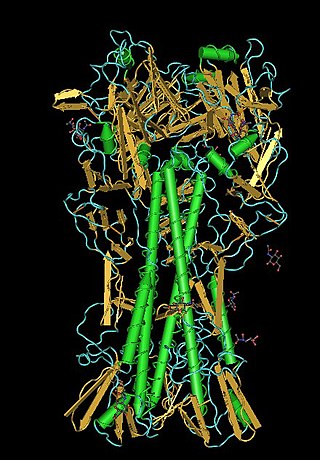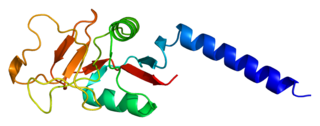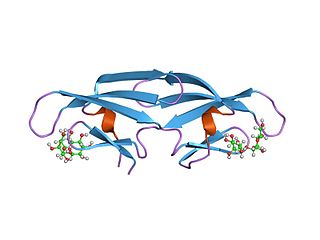Related Research Articles

Lectins are carbohydrate-binding proteins that are highly specific for sugar groups that are part of other molecules, so cause agglutination of particular cells or precipitation of glycoconjugates and polysaccharides. Lectins have a role in recognition at the cellular and molecular level and play numerous roles in biological recognition phenomena involving cells, carbohydrates, and proteins. Lectins also mediate attachment and binding of bacteria, viruses, and fungi to their intended targets.
Pattern recognition receptors (PRRs) play a crucial role in the proper function of the innate immune system. PRRs are germline-encoded host sensors, which detect molecules typical for the pathogens. They are proteins expressed mainly by cells of the innate immune system, such as dendritic cells, macrophages, monocytes, neutrophils, as well as by epithelial cells, to identify two classes of molecules: pathogen-associated molecular patterns (PAMPs), which are associated with microbial pathogens, and damage-associated molecular patterns (DAMPs), which are associated with components of host's cells that are released during cell damage or death. They are also called primitive pattern recognition receptors because they evolved before other parts of the immune system, particularly before adaptive immunity. PRRs also mediate the initiation of antigen-specific adaptive immune response and release of inflammatory cytokines.

DC-SIGN also known as CD209 is a protein which in humans is encoded by the CD209 gene.

The lectin pathway or MBL pathway is a type of cascade reaction in the complement system, similar in structure to the classical complement pathway, in that, after activation, it proceeds through the action of C4 and C2 to produce activated complement proteins further down the cascade. In contrast to the classical complement pathway, the lectin pathway does not recognize an antibody bound to its target. The lectin pathway starts with mannose-binding lectin (MBL) or ficolin binding to certain sugars.
Cyanovirin-N (CV-N) is a protein produced by the cyanobacterium Nostoc ellipsosporum that displays virucidal activity against several viruses, including human immunodeficiency virus (HIV). A cyanobacterial protein called cyanovirin-N (CV-N) has strong anti-human immunodeficiency virus (HIV) neutralizing properties. The virucidal activity of CV-N is mediated through specific high-affinity interactions with the viral surface envelope glycoproteins gp120 and gp41, as well as to high-mannose oligosaccharides found on the HIV envelope. In addition, CV-N is active against rhinoviruses, human parainfluenza virus, respiratory syncytial virus, and enteric viruses. The virucidal activity of CV-N against influenza virus is directed towards viral haemagglutinin.
Collectins (collagen-containing C-type lectins) are a part of the innate immune system. They form a family of collagenous Ca2+-dependent defense lectins, which are found in animals. Collectins are soluble pattern recognition receptors (PRRs). Their function is to bind to oligosaccharide structure or lipids that are on the surface of microorganisms. Like other PRRs they bind pathogen-associated molecular patterns (PAMPs) and danger-associated molecular patterns (DAMPs) of oligosaccharide origin. Binding of collectins to microorganisms may trigger elimination of microorganisms by aggregation, complement activation, opsonization, activation of phagocytosis, or inhibition of microbial growth. Other functions of collectins are modulation of inflammatory, allergic responses, adaptive immune system and clearance of apoptotic cells.

Mannose-binding lectin (MBL), also called mannan-binding lectin or mannan-binding protein (MBP), is a lectin that is instrumental in innate immunity as an opsonin and via the lectin pathway.

Galectins are a class of proteins that bind specifically to β-galactoside sugars, such as N-acetyllactosamine, which can be bound to proteins by either N-linked or O-linked glycosylation. They are also termed S-type lectins due to their dependency on disulphide bonds for stability and carbohydrate binding. There have been about 15 galectins discovered in mammals, encoded by the LGALS genes, which are numbered in a consecutive manner. Only galectin-1, -2, -3, -4, -7, -7B, -8, -9, -9B, 9C, -10, -12, -13, -14, and -16 have been identified in humans. Galectin-5 and -6 are found in rodents, whereas galectin-11 and -15 are uniquely found in sheep and goats. Members of the galectin family have also been discovered in other mammals, birds, amphibians, fish, nematodes, sponges, and some fungi. Unlike the majority of lectins they are not membrane bound, but soluble proteins with both intra- and extracellular functions. They have distinct but overlapping distributions but found primarily in the cytosol, nucleus, extracellular matrix or in circulation. Although many galectins must be secreted, they do not have a typical signal peptide required for classical secretion. The mechanism and reason for this non-classical secretion pathway is unknown.

Langerin (CD207) is a type II transmembrane protein which is encoded by the CD207 gene in humans. It was discovered by scientists Sem Saeland and Jenny Valladeau as a main part of Birbeck granules. Langerin is C-type lectin receptor on Langerhans cells (LCs) and in mice also on dermal interstitial CD103+ dendritic cells (DC) and on resident CD8+ DC in lymph nodes.

Griffithsin is a protein isolated from the red algae Griffithsia. It has a 121-amino acid sequence which exhibits a Jacalin-like lectin fold. Several structures of this protein have been solved by X-ray crystallography and deposited in the PDB. It has been shown in vitro to be a highly potent HIV entry inhibitor. It is currently being investigated as a potential microbicide for use in the prevention of the transmission of HIV.

Protein ERGIC-53 also known as ER-Golgi intermediate compartment 53 kDa protein or lectin mannose-binding 1 is a protein that in humans is encoded by the LMAN1 gene.

Neutral alpha-glucosidase AB is an enzyme that in humans is encoded by the GANAB gene.

GBA2 is the gene that encodes the enzyme non-lysosomal glucosylceramidase in humans. It has glucosylceramidase activity.
The following outline is provided as an overview of and topical guide to immunology:

MBL deficiency or mannose-binding lectin deficiency is an illness that has an impact on immunity. Low levels of mannose-binding lectin, an immune system protein, are present in the blood of those who have this illness. It's unclear if this deficiency increases the risk of recurrent infections in those who are affected.

Cytosolic beta-glucosidase, also known as cytosolic beta-glucosidase-like protein 1, is a beta-glucosidase enzyme that in humans is encoded by the GBA3 gene.

In molecular biology, the CVNH domain is a conserved protein domain. It is found in the sugar-binding antiviral protein cyanovirin-N (CVN) as well as proteins from filamentous ascomycetes and in the fern Ceratopteris richardii.

In molecular biology, the jacalin-like lectin domain is a mannose-binding lectin domain with a beta-prism fold consisting of three 4-stranded beta-sheets, with an internal pseudo 3-fold symmetry. Some lectins in this group stimulate distinct T- and B-cell functions, such as Jacalin, which binds to the T-antigen and acts as an agglutinin. This domain is found in 1 to 6 copies in lectins. The domain is also found in the salt-stress induced protein from rice and an animal prostatic spermine-binding protein.

In molecular biology the L-like lectin domain is a protein domain found in lectins which are similar to the leguminous plant lectins.
Avadhesha Surolia is a glycobiologist at the Indian Institute of Science (IISc), Bangalore. He was born in Kishangarh, Rajasthan, India. Presently, he is an honorary professor at the Molecular Biophysics Unit, IISc and holds the Bhatnagar fellowship of the Council of Scientific and Industrial Research (CSIR). He is known for his work on lectin structure and interactions, orientation and dynamics of cell surface carbohydrate receptors and protein folding, diabetes, antimalarials and anti-cancer agents based on curcumin, flavonoids, etc. In addition, neuropathic pain, neurodegenerative disorders and the link between immunity and obsessive–compulsive disorder are areas of his current interest
References
- 1 2 3 4 Swanson MD, Winter HC, Goldstein IJ, Markovitz DM (March 2010). "A Lectin Isolated from Bananas Is a Potent Inhibitor of HIV Replication". J. Biol. Chem. 285 (12): 8646–55. doi: 10.1074/jbc.M109.034926 . PMC 2838287 . PMID 20080975.
- 1 2 3 4 Koshte VL, van Dijk W, van der Stelt ME, Aalberse RC (December 1990). "Isolation and characterization of BanLec-I, a mannoside-binding lectin from Musa paradisiac (banana)". Biochem. J. 272 (3): 721–6. doi:10.1042/bj2720721. PMC 1149768 . PMID 2268297.
- 1 2 3 Peumans WJ, Zhang W, Barre A, et al. (September 2000). "Fruit-specific lectins from banana and plantain". Planta. 211 (4): 546–54. Bibcode:2000Plant.211..546P. doi:10.1007/s004250000307. PMID 11030554.
- ↑ Koshte VL, Aalbers M, Calkhoven PG, Aalberse RC (1992). "The potent IgG4-inducing antigen in banana is a mannose-binding lectin, BanLec-I". Int. Arch. Allergy Immunol. 97 (1): 17–24. doi:10.1159/000236090. PMID 1582693.
- ↑ Hopper, Jonathan T.S.; Ambrose, Stephen; Grant, Oliver C.; Krumm, Stefanie A.; Allison, Timothy M.; Degiacomi, Matteo T.; Tully, Mark D.; Pritchard, Laura K.; Ozorowski, Gabriel; Ward, Andrew B.; Crispin, Max; Doores, Katie J.; Woods, Robert J.; Benesch, Justin L.P.; Robinson, Carol V.; Struwe, Weston B. (May 2017). "The Tetrameric Plant Lectin BanLec Neutralizes HIV through Bidentate Binding to Specific Viral Glycans". Structure. 25 (5): 773–782.e5. doi:10.1016/j.str.2017.03.015. PMC 5556678 . PMID 28434916.
- ↑ Gupta G, Vishveshwara S, Surolia A (March 2009). "Stability of dimeric interface in banana lectin: Insight from molecular dynamics simulations". IUBMB Life. 61 (3): 252–60. doi: 10.1002/iub.162 . PMID 19189367.
- 1 2 3 Gupta G, Sinha S, Surolia A (August 2008). "Unfolding energetics and stability of banana lectin". Proteins. 72 (2): 754–60. doi:10.1002/prot.21961. PMID 18260105.
- ↑ Meagher JL, Winter HC, Ezell P, Goldstein IJ, Stuckey JA (October 2005). "Crystal structure of banana lectin reveals a novel second sugar binding site". Glycobiology. 15 (10): 1033–42. doi: 10.1093/glycob/cwi088 . PMID 15944373.
- 1 2 "Study: Chemical in Bananas Could Help Fight HIV", Fox News Channel, March 16, 2010
- ↑ "Protein in bananas could help block spread of HIV, University of Michigan researchers say", AnnArbor.com, March 15, 2010